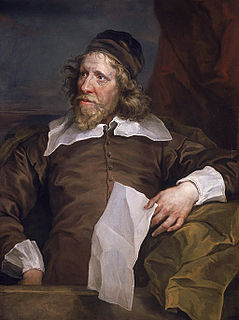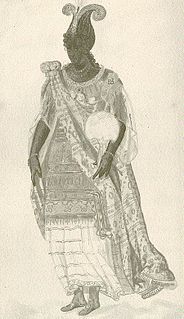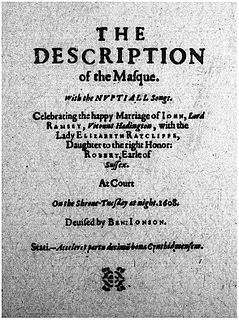
Inigo Jones was the first significant architect in England and Wales in the early modern period, and the first to employ Vitruvian rules of proportion and symmetry in his buildings. As the most notable architect in England and Wales, Jones was the first person to introduce the classical architecture of Rome and the Italian Renaissance to Britain. He left his mark on London by his design of single buildings, such as the Queen's House which is the first building in England designed in a pure classical style, and the Banqueting House, Whitehall, as well as the layout for Covent Garden square which became a model for future developments in the West End. He made major contributions to stage design by his work as theatrical designer for several dozen masques, most by royal command and many in collaboration with Ben Jonson.

Lady Mary Wroth was an English noblewoman and a poet of the English Renaissance. A member of a distinguished literary family, Lady Wroth was among the first female English writers to have achieved an enduring reputation. Mary Wroth was niece to Mary Herbert née Sidney, and to Sir Philip Sidney, a famous Elizabethan poet-courtier.

The Masque of Blackness was an early Jacobean era masque, first performed at the Stuart Court in the Banqueting Hall of Whitehall Palace on Twelfth Night, 6 January 1605. It was written by Ben Jonson at the request of Anne of Denmark, the queen consort of King James I, who wished the masquers to be disguised as Africans. Anne was one of the performers in the masque along with her court ladies, all of whom appeared in blackface makeup.
Love's Triumph Through Callipolis was the first masque performed at the Stuart Court during the reign of King Charles I, and the first in which a reigning monarch appeared. The work was written by Ben Jonson, with costumes, sets, and stage effects designed by Inigo Jones, and music by Nicholas Lanier. This play Also played in Greece national theatre in 1979 together with the Johnsons masques Oberon, the faery prince and News from the new world discovered in the moon.
Oberon, the Faery Prince was a masque written by Ben Jonson, with costumes, sets and stage effects designed by Inigo Jones, and music by Alfonso Ferrabosco and Robert Johnson. Oberon saw the introduction to English Renaissance theatre of scenic techniques that became standard for dramatic productions through the coming centuries.
Love Restored was a Jacobean era masque, written by Ben Jonson; it was performed on Twelfth Night, 6 January 1612, and first published in 1616. The Dictionary of National Biography says of the masque, "This vindication of love from wealth is a defense of the court revels against the strictures of the puritan city."

The Hue and Cry After Cupid, or A Hue and Cry After Cupid, also Lord Haddington's Masque or The Masque at Lord Haddington's Marriage, or even The Masque With the Nuptial Songs at the Lord Viscount Haddington's Marriage at Court, was a masque performed on Shrove Tuesday night, 9 February 1608, in the Banqueting House at Whitehall Palace. The work was written by Ben Jonson, with costumes, sets, and stage effects designed by Inigo Jones, and with music by Alfonso Ferrabosco – the team of creators responsible for previous and subsequent masques for the Stuart Court.
The Golden Age Restored was a Jacobean era masque, written by Ben Jonson and designed by Inigo Jones; it was performed on 1 January and 6 January 1616, almost certainly at Whitehall Palace.
Mercury Vindicated from the Alchemists at Court is a Jacobean-era masque, written by Ben Jonson and designed by Inigo Jones. It was performed at Whitehall Palace on Twelfth Night, 6 January 1615. King James I liked it so much that he ordered a repeat performance the following Sunday, 8 January.
The Fortunate Isles and Their Union is a Jacobean era masque, written by Ben Jonson and designed by Inigo Jones, and performed on 9 January 1625. It was the last masque acted before King James I of England, and therefore the final masque of the Jacobean era.
Neptune's Triumph for the Return of Albion was a Jacobean era masque, written by Ben Jonson, and designed by Inigo Jones. The masque is notable for the contradictory historical evidence connected with it and the confusion it caused among generations of scholars and critics.
Pleasure Reconciled to Virtue is a Jacobean era masque, written by Ben Jonson and designed by Inigo Jones. It was first performed on Twelfth Night, 6 January 1618, in the Banqueting House at Whitehall Palace. The work's failure on its initial performance, and its subsequent revision, marked a significant development in Jonson's evolving masque technique.
The Masque of Augurs was a Jacobean era masque, written by Ben Jonson and designed by Inigo Jones. It was performed, most likely, on Twelfth Night, 6 January 1622.
Time Vindicated to Himself and to his Honours was a late Jacobean era masque, written by Ben Jonson and with costumes, sets, and stage effects designed by Inigo Jones. James's son and heir Prince Charles led the dances of the principal masquers, as he had in several previous masques at the Stuart Court.
Luminalia or The Festival of Light was a late Caroline era masque or "operatic show", with an English libretto by Sir William Davenant, designs by Inigo Jones, and music by composer Nicholas Lanier. Performed by Queen Henrietta Maria and her ladies in waiting on Shrove Tuesday, 6 February 1638, it was one of the last and most spectacular of the masques staged at the Stuart Court.
The Faithful Shepherdess is a Jacobean era stage play, the work that inaugurated the playwriting career of John Fletcher. Though the initial production was a failure with its audience, the printed text that followed proved significant, in that it contained Fletcher's influential definition of tragicomedy. Like many of Fletcher's later tragicomedies, The Faithful Shepherdess deals with the darker side of sexuality and sexual jealousy, albeit within a comic framework.
The Gypsies Metamorphosed, alternatively titled The Metamorphosed Gypsies,The Gypsies' Metamorphosis, or The Masque of Gypsies, was a Jacobean era masque written by Ben Jonson, with music composed by Nicholas Lanier. It was first performed on 3 August 1621, and was the biggest popular hit of Jonson's masquing career.
The Vision of Delight was a Jacobean era masque written by Ben Jonson. It was most likely performed on Twelfth Night, 6 January 1617 in the Banqueting House at Whitehall Palace, and repeated on 19 January that year.
Lovers Made Men, alternatively titled The Masque of Lethe or The Masque at Lord Hay's, was a Jacobean era masque, written by Ben Jonson, designed by Inigo Jones, and with music composed by Nicholas Lanier. It was performed on Saturday 22 February 1617, and was significant in the development and acceptance of opera in seventeenth-century England.
News from the New World Discovered in the Moon was a Jacobean era masque, written by Ben Jonson; it was first performed before King James I on 7 January 1620, with a second performance on 29 February the same year. Jonson's text comments on significant recent developments in astronomy and journalism. The text of the masque was first published in the second folio collection of Jonson's works in 1641.